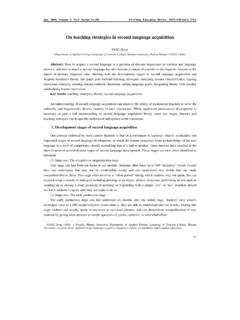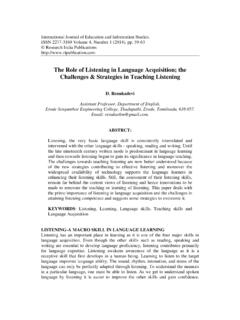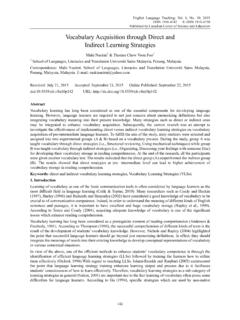Transcription of Behaviorist theory on language acquisition
1 Behaviorist theory ON language LEARNING AND acquisition . Introduction There are some basic theories advanced to describe how language is acquired, learnt and taught. The Behaviorist theory , Mentalist theory (Innatism), Rationalist theory (otherwise called Cognitive theory ), and Interactionism are some of these theories. Of these, Behaviorist theory and mentalist theory are mainly applicable to the acquisition of native languages while the rest can account for foreign language acquisition . Yet, these four fundamental theories of language acquisition cannot be totally divorced from each other, for "the objectives of second language learning are not necessarily entirely determined by native language competence inevitably serves as a foil against which to set second language learning.
2 " ( Stem, .1983; 30). Mother Tongue and Foreign language Learning These five basic theories are, furthermore, very much complementary to each other, serving different types of learners or representing various cases of language learning. They must not automatically make us presume that first and second language learning are identical or alike processes, though second language learning is strongly tied up with first language acquisition . Obviously, native language growth must pave the way for foreign language growth. Then these five basic language learning theories are fundamental pillars of language learning whose relevance to education is undeniable. The Principle of the Behaviorist theory The Behaviorist theory believes that infants learn oral language from other human role models through a process involving imitation, rewards, and practice.
3 Human role models in an infant's environment provide the stimuli and rewards, (Cooter & Reutzel, 2004). When a child attempts oral language or imitates the sounds or speech patterns they are usually praised and given affection for their efforts. Thus, praise and affection becomes the rewards. However, the Behaviorist theory is scrutinized for a variety of reasons. If rewards play such a vital component in language development, what about the parent who is inattentive or not present when the child attempts speech? If a baby's language learning is motivated strictly by rewards would the speech attempts stop merely for lack of rewards (Cooter & Reutzel, 2004)? Other cases against this theory include learning the use and meaning of abstract words, evidence of novel forms of language not modeled by others, and uniformity of language acquisition in humans.
4 (Cooter & Reutzel, 2004). The Background of the Behaviorist theory The Behaviorist theory believes that infants learn oral language from other human role models through a process involving imitation, rewards, and practice. Human role models in an infant's environment provide the stimuli and rewards, (Cooter & Reutzel, 2004). When a child attempts oral language or imitates the sounds or speech patterns they are usually praised and given affection for their efforts. Thus, praise and affection becomes the rewards. However, the Behaviorist theory is scrutinized for a variety of reasons. If rewards play such a vital component in language development, what about the parent who is inattentive or not present when the child attempts speech?
5 If a baby's language learning is motivated strictly by rewards would the speech attempts stop merely for lack of rewards (Cooter & Reutzel, 2004)? Other cases against this theory include learning the use and meaning of abstract words, evidence of novel forms of language not modeled by others, and uniformity of language acquisition in humans . (Cooter & Reutzel, 2004). Behaviorist theory , which is basically a psychological theory in its essence, founded by Watson, is actually a theory of native language learning, advanced in part as a reaction to traditional grammar. The supporters of this theory are Leonard Bloomfield, Mowrer, Skinner, and Staats. Behaviorism was advanced in America as a new approach to psychology in the early decades of the 20th-century by making a particular emphasis on the importance of verbal behavior, and received a considerable trust from the educational world of 1950s.
6 The major principle of the Behaviorist theory rests on the analyses of human behavior in observable stimulus-response interaction and the association between them. Thorndike was the first Behaviorist to explore the area that learning is the establishment of associations on particular process of behavior and consequences of that behavior. Basically, "the Behaviorist theory of stimulus-response learning, particularly as developed in the operant conditioning model of Skinner, considers all learning to be the establishment of habits as a result of reinforcement and reward" (Wilga Rivers, 1968, 73). This is very reminiscent of Pavlov's experiment which indicates that stimulus and response work together. According to this category, the babies obtain native language habits via varied babblings which resemble the appropriate words repeated by a person or object near him.
7 Since for his babblings and mutterings he is rewarded, this very reward reinforces further articulations of the same sort into grouping of syllables and words in a similar situation. In this way, he goes on emitting sounds, groups of sounds, and as he grows up he combines the sentences via generalizations and analogy (as in *goed for went, *doed, for did, so on), which in some complicated cases, condition him to commit errors by articulating in permissible structures in speech. By the age of five or six, or babblings and mutterings grow into socialized speech but little by little they are internalized as implicit speech, and thus many of their utterances become indistinguishable from the adults. This, then, obviously, means that Behaviorist theory is a theory of stimulus-response psychology.
8 "Through a trial-and-error process, in which acceptable utterances are reinforced by comprehension and approval, and un acceptable utterances are inhibited by the lack of reward, he gradually learns to make finer and finer discriminations until his utterances approximate more and more closely the speech of the community in which he is growing up (Wilga M. Rivers, 1968; 73). To put it in other words, children develop a natural affinity to learn the language of their social surroundings whose importance both over language learning and teaching must never be underestimated. In this respect Behaviorist theory stresses the fact that "human and animal learning is a process of habit formation. A highly complex learning task, according to this theory may be learned by being broken' down into smaIl habits.
9 These are formed correct or incorrect responses, are rewarded or, punished, respectively'.(Hubbard Jones and Thornton Wheeler, 1983; 326). Thus it is clear that the acquisition of learning in infancy is governed the acquisition of other habits. Basic Tenents of Behaviorist theory The following principles illustrate the operating principles of behaviorism: Counterarguments on Behaviorist theory of language Learning Needless to say, language teaching anticipates certain theories on language learning because language learning as a fruitful area that embodies the working of human behavior and mental processes of the learners. Each theory may not be complete model for the investigation of language learning. The following counter-arguments can be made upon the working principles of Behaviorist theory : 1) Basic strategies of language learning within the scope of Behaviorist theory are imitation, reinforcement, and rewarding.
10 However, researches made on the acquisition of learning have demonstrated that children's imitation of structures show evidence of almost no innovation;. moreover children "vary considerably in the amount that they imitate" ( Bloom, L. Hood, and Lightbown, 1974; 380-420). Since children do not imitate such structures like words, phrases, clauses and sentences at the same rate they will naturally learn at different rates even though it must be admitted that imitation is very useful in the acquisition of new vocabulary items. As for reinforcement, "Unfortunately this view of learning receives little support from the available evidence" (Herbert H. Clark and Eve V. Clark, 1977; 336), for the parents only correct the sample structures, and complex structures are occasionally corrected.









